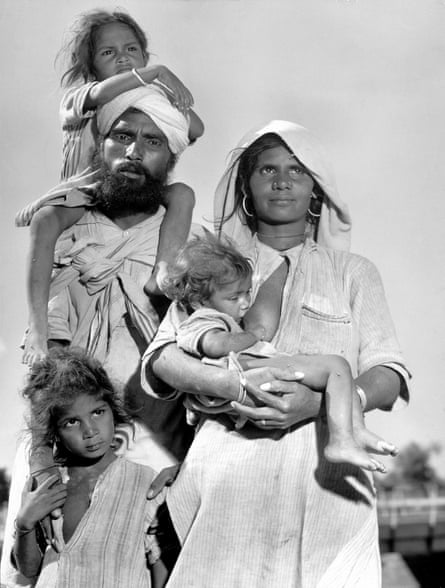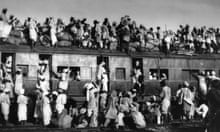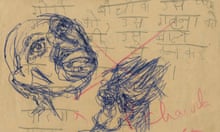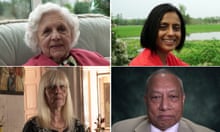On 3 June 1947, only six weeks before British India was carved up, a group of eight men sat around a table in New Delhi and agreed to partition the south Asian subcontinent.
Photographs taken at that moment reveal the haunted and nervous faces of Jawaharlal Nehru, the Indian National Congress leader soon to become independent India’s first prime minister, Mohammad Ali Jinnah, head of the Muslim League and Pakistan’s first governor-general and Louis Mountbatten,the last British viceroy.
Yet the public also greeted this agreement with some cautious hope. Nobody who agreed to the plan realised that partition was unleashing one of the worst calamities of the 20th century. Only weeks later, the full scale of the tragedy was apparent.
The north-eastern and north-western flanks of the country, made up of Muslim majorities, became Pakistan on 14 August 1947. The rest of the country, predominantly Hindu, but also with large religious minorities peppered throughout, became India. Sandwiched between these areas stood the provinces of Bengal (in the east) and Punjab (in the north-west), densely populated agricultural regions where Muslims, Hindus and Punjabi Sikhs had cultivated the land side by side for generations. The thought of segregating these two regions was so preposterous that few had ever contemplated it, so no preparations had been made for a population exchange.
“Do you foresee any mass transfer of population?” one journalist asked Mountbatten at a press conference in Delhi, after the plan was announced. “Personally, I don’t see it,” he replied. “There are many physical and practical difficulties involved. Some measure of transfer will come about in a natural way … perhaps governments will transfer populations. Once more, this is a matter not so much for the main parties as for the local authorities living in the border areas to decide.”
However, people took fright and, in the face of mounting violence, took matters into their own hands. Many did not want “minorities” in their new countries. Others did not want to become “minorities” with all the attendant horrors this now implied. Refugees started to cross over from one side to the other in anticipation of partition. The borderlines, announced on 17 August – two days after independence – cut right through these two provinces and caused unforeseen turmoil. Perhaps a million people died, from ethnic violence and also from diseases rife in makeshift refugee camps.
The epicentre was Punjab, yet many other places were affected, especially Bengal (often overlooked in the commemorations), Sindh, Uttar Pradesh, Bihar, Kashmir and beyond. Lahore – heir to the architecture of Mughal, Sikh and British rule, and famed for its poets, universities and bookshops – was reduced in large quarters to rubble. In Amritsar, home of the Golden Temple, and also known for its carpet and silk weavers, it took more than five years to clear the wreckage. There were more than 600 refugee camps all over the subcontinent, 70,000 women had suffered sexual violence and the issue of the princely states, especially Kashmir, remained unresolved. Many hopes had been cruelly dashed. The act of partition set off a spiral of events unforeseen and unintended by anyone, and the dramatic upheavals changed the terms of the whole settlement.
The stories make us flinch. Bloated and distorted bodies surfacing in canals months after a riot, young pregnant women left dismembered by roadsides. One newspaper report tells of an unnamed man from a village “whose family had been wiped out”, who on meeting Jinnah as he toured the Pakistani camps in 1947, “sobbed uncontrollably”. Up to 15 million people left their homes to begin a new life in India or Pakistan, and by September 1947 the formal exchange of population across the Punjab borderlines had become government policy.
Conscious of the fact that time is running out to record eye-witness testimony from the survivors of 1947, many people have collected memories and oral histories in the past decades. These can be downloaded at the click of a button, and have been collected by volunteers, family members and historians. Partition history used to be all about the high politics and the relative responsibilities of Mountbatten, Jinnah, Gandhi and Nehru – these four men have always towered over the story, and ultimately their animosities and the reasons they failed to agree on a constitutional settlement make them the leading actors of an enduring and gripping drama – but today many historians are far more interested in the fate of refugees in the camps, the ways in which villagers experienced the uprooting of 1947, or how they rebuilt their lives in the aftermath.

There is still a mystery at the dark heart of partition. Ultimately, it remains a history layered with absence and silences, even while many mourn and talk about their own trauma. Nearly every Punjabi family – Indian and Pakistani – can tell a tale about a relative uprooted in the night, the old friends and servants left behind, the nostalgia for a cherished house now fallen into new hands. Far fewer are willing to discuss the role of their own locality in contributing to the violence. Rarely, oral histories tell of culpability and betrayal; more often, guilt and silences stalk the archive.
Who were the killers? Why did they kill? Much evidence points not to the crazy and inexplicable actions of mad, uneducated peasants with sticks and stones, but to well-organised and well-motivated groups of young men, who went out – particularly in Punjab – to carry out ethnic cleansing. These men, often recently demobilised from the second world war, had been trained in gangs and militias, were in the pay of shopkeepers and landlords, and had often been well drilled and well equipped. They took on the police and even armed soldiers on some occasions.
There are evident parallels with Rwanda and Bosnia, in the collapse of old communities and the simplification of complex identities. Militant leaders tried to make facts on the ground by carving out more land for their own ethnic group. They used modern tactics of propaganda and bloodshed that are familiar today. Many newspapers had caricatured the “other” community for decades. Compared with the way Germans look with clear eyes at their past, south Asia is still mired in denial.
Volunteers could be seen marching along the major roads on their way to join the battle in the summer of 1947. Some wore uniforms, were armed with swords, spears and muzzle-loading guns. One gang intercepted on their return from fighting even had an armoured elephant. The militias also worked hand in glove with the local leaders of princely states who channelled funds and arms. They answered to local power brokers and sometimes to the prompts of politicians. This helps explain the scale of the violence.
In other places, it was a case of neighbour turning against neighbour, often in a deluded form of “self-defence” or revenge, sometimes as a cover for resolving old family feuds, for getting back at a mercenary landlord or as a chance to loot. In the main, people were whipped up by demonisation of the other, encouraged by the rhetoric of politicians and a feverish media.
The British government had repeatedly delayed granting freedom in the 1930s, when it might have been more amicably achieved. After waiting decades for freedom, this was a moment of intense anxiety and fear. Propaganda had built up during the preceding war years, especially while Gandhi and the Indian National Congress leaders were shut in prison in the 1940s; Jinnah saw the second world war as a blessing in disguise for this very reason. Ultimately, 1947 became a perfect storm as many contingencies collided.
On the British side, the planning was shoddy and the date was rushed forward by a whole year; the original plan was for a British departure in mid-1948. Mountbatten prioritised European lives and made sure he didn’t get British troops entangled in a guerilla war. And the British bungled the details: there was a sweeping idea behind partition but almost nothing in place to deal with how this unparalleled division would be achieved on the ground. The limited military force put in place in July, the Punjab Boundary Force, was understaffed and spread over a vast distance. This was a textbook case of a power vacuum.
Where did the power lie as the British left and the new states formed? The British come out of the story looking ill-prepared, naive and even callous.
But could the British have settled the competing nationalist visions in south Asia in the 1940s, and could they have created a constitution to please everybody? This is the great hypothetical question. Endless rounds of previous negotiations had ended in disappointment and overlaying new nation states over the grid of messy, large, complex empires was a challenge all over the world.
Many Muslim Leaguers would have accepted power within a federal, decentralised and unified India in 1946, while many members of the Indian National Congress resisted power-sharing schemes. But, ultimately, we just do not know how the alternatives would have worked. In the event, Jinnah pushed for Pakistan, and the final compromise was to create two states by drawing borders across Punjab and Bengal. All the key leaders – including Jinnah, Nehru and Mountbatten – agreed to this plan, and with some relief: they hoped it might actually bring an end to violence and herald a new beginning.
The tragedy of partition is that the stories of extreme violence in 1947 have provided fodder to opposing perspectives ever since, and myths have crystallised around the origins of India and Pakistan. As Gandhi put it in the summer of 1947, “Today, religion has become fossilised.” Many backdated histories have been written after the event, and are present in school textbooks and the national media in Asia. This sweeps aside any appreciation of the hybrid, Indo-Islamic world that flourished before the British began their conquest in the 18th century. The land in which vernacular Sanskrit-based languages were cross-pollinated with Turkish, Persian, and Arabic, in which Rajput princesses married Mughal rulers, and musical and artistic styles had thrived on the fusion of influences from central Asia and local courtly cultures.
This world of more fluid identities and cultures was gradually dismantled throughout the 19th century under British rule and then smashed by partition. It becomes ever harder, today, to imagine the pre-partitioned Indian subcontinent.
In the south Asian case, the historical conflict is now acted out on a different, international stage. India and Pakistan stand frozen in a cold war, with nuclear missiles pointed at each other. At least one billion people living in the region today were not even born when partition took place and south Asia has many more immediate and far more pressing problems: water supply, environmental crisis and adaptation to climate change. Nonetheless, a sense of shared history, and a more multidimensional understanding of what happened in 1947 is also vital for the future of the region. After 70 years, this anniversary is a valuable moment for reflection and provides an opportunity to commemorate the dead. It may also provide a chance to ask questions, to disrupt some of the cliches, and to think once again about how we tell this history.
Yasmin Khan is an associate professor of history at Oxford and author of The Great Partition: the making of India and Pakistan
Timeline
1885 The Indian National Congress meets for the first time in Bombay (now Mumbai). The party is the heart of the long struggle for independence from Britain.
1906 Formation of the Muslim League, initially committed to protecting the rights of Muslims within India. It would not call for an independent Muslim-majority state for several decades.
1920 Icon of independence Mahatma Gandhi launches campaign of non-violent resistance.
1933 Muslim nationalist Choudhry Rehmat Ali calls for a state of “Pakstan” in a pamphlet – the first appearance of the name. It was derived from the names of some areas he saw as making up the state –with P for Punjab and K for Kashmir – but also meaning land of the pure. An “i” is later added to improve pronounciation.
1940 The Muslim League demands a separate state for Muslims of India, in the Lahore Resolution, on the grounds that they will always be vulnerable in a Hindu-majority state. Leader Muhammad Ali Jinnah, Pakistan’s founding father, says India’s Muslim community is “very apprehensive and can trust nobody”.
1944 Talks between Gandhi and Jinnah end in failure.
1947 In February, prime minister Clement Atlee announces Britain’s intention to leave India by June 1948, a timeline that is abruptly accelerated within months. In June, Britain’s viceroy Lord Mountbatten presents Indian leaders with the partition plan. The borders are sketched out by a British lawyer with little knowledge of India and using old maps and census figures.In August, Pakistan and India celebrate independence a day apart, the former on the 14th, the latter a day later. On 18 August the new borders are announced, cutting through communities, leaving millions stranded on the “wrong” side of the border and triggering violence. In October, the state of Jammu and Kashmir, which is claimed by both countries, becomes a part of India. This decision triggers the first war between the new neighbours, and will remain a major source of tension.








